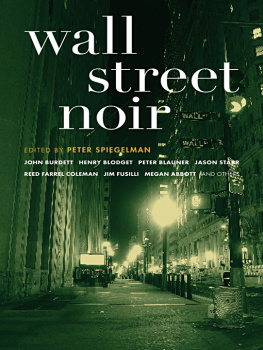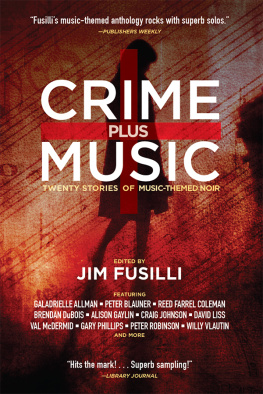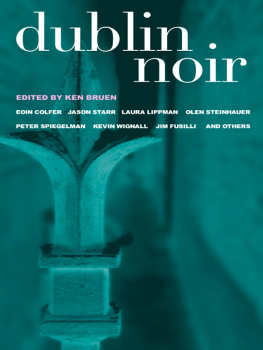This collection is comprised of works of fiction. All names, characters, places, and incidents are the product of the authors imaginations. Any resemblance to real events or persons, living or dead, is entirely coincidental.
Published by Akashic Books
2007 Akashic Books
Series concept by Tim McLoughlin and Johnny Temple
Map by Sohrab Habibion
ePub ISBN-13: 978-1-936-07054-1
ISBN-13: 978-1-933354-23-1
ISBN-10: 1-933354-23-2
Library of Congress Control Number: 2006938154
All rights reserved
First printing
Akashic Books
PO Box 1456
New York, NY 10009
info@akashicbooks.com
www.akashicbooks.com
ALSO IN THE AWARD-WINNING AKASHIC NOIR SERIES:
Baltimore Noir, edited by Laura Lippman
Brooklyn Noir, edited by Tim McLoughlin
Brooklyn Noir 2: The Classics, edited by Tim McLoughlin
Chicago Noir, edited by Neal Pollack
D.C. Noir, edited by George Pelecanos
Dublin Noir, edited by Ken Bruen
London Noir, edited by Cathi Unsworth
Los Angeles Noir, edited by Denise Hamilton
Manhattan Noir, edited by Lawrence Block
Miami Noir, edited by Les Standiford
New Orleans Noir, edited by Julie Smith
San Francisco Noir, edited by Peter Maravelis
Twin Cities Noir, edited by Julie Schaper & Steven Horwitz
FORTHCOMING:
Bronx Noir, edited by S.J. Rozan
Brooklyn Noir 3, edited by Tim McLoughlin & Thomas Adcock
Delhi Noir (India), edited by Hirsh Sawhney
Detroit Noir, edited by Eric Olsen & Chris Hocking
Havana Noir (Cuba), edited by Achy Obejas
Istanbul Noir (Turkey), edited by Mustafa Ziyalan & Amy Spangler
Lagos Noir (Nigeria), edited by Chris Abani
Las Vegas Noir, edited by Jarret Keene & Todd James Pierce
Paris Noir (France), edited by Aurlien Masson
Queens Noir, edited by Robert Knightly
Rome Noir (Italy), edited by Chiara Stangalino & Maxim Jakubowski
Toronto Noir (Canada), edited by Janine Armin & Nathaniel G. Moore
For Alice
Acknowledgments
All books are collaborative efforts, but none more so than anthologies, and so I owe many thanks to many people: first and foremost, to all of the contributors, for their talents, time, good humor, and professionalism; to Johnny Temple, for seeing the possibilities; and to Reed Coleman, for a good eye and sound advice.
TRADITION
W all Street is long on tradition. The opening bell, the floor traders vivid jackets, black Town Cars at curbside, long nights spent hunched over spreadsheets, helicopters to the Hamptons, lap-dance tabs that run to five figuresthese shared rituals and experiences bind generations of money folk one to the other, and so preserve and propagate the culture. But theres one link in that chain more tarnished than the rest, and less fondly regarded: crime.
Financial crime has a history much longer than Wall Streetsby several thousand years at least. Conflicted interests, insider trading, and outright fraud are as old as the first marketplacesas old as the first swap of flint chips for bearskins, no doubtand theyve been part and parcel of Wall Street since the days of the old Dutch barricade. Just as Wall Street has raised finance to high art (or at least, to expensive spectacle), so has it done crime bigger and flashier than its Old World antecedents. Sure, there was the South Sea scam, and that business with the Vatican Bank, but Wall Street has given us Robert Vesco, Ivan Boesky, and the Hunt brothers, not to mention playing midwife to Enron, Adelphia, and Qwest. And unlike some traditions (floor traders are an endangered species at the NYSE, and the bean counters are ever more skeptical about receipts that come dotted with glitter), crime on Wall Street actually has a future.
Caveats about past performance and future results notwithstanding, I feel pretty safe in this prediction. The news gives me comfort. Every day seems to bring more stories of front-running, insider trading, and cooked books, and some business blogs (the more ironic ones, to be sure) even offer travel tips for white-collar bail-jumpers. Crime endures on Wall Street through cycles of boom and bust, and waves of regulation, deregulation, and re-regulationa constant in an otherwise changing world.
This persistence and bright future of crime stands in marked contrast to the public image the Street projects these days. Viewed from a distance, on the cable business channels, say, it seems like such a clean, well-lighted place. The sort of place where investment decisions are guided by careful formulae and subtle strategies, by dispassionate consideration of all the facts and figures; the sort of place where cool reason prevails. The information is out there for all to see; you just need to interpret it correctly. Its as pure a meritocracy as one could ask for, so get some software, open a margin account, and knock yourself out. Its a comforting notionbut it doesnt hold up on close inspection. Close up, you see distortions in how the information flows (remember that suspicious trading activity before the merger announcements?). You see the sheen of sweat, and you can almost smell the fear and greed.
News reports of Wall Street crime dont often focus on the gritty parts. Not surprisingly, theyre usually more concerned with the nuts and bolts of a scamthe who did what when, the mechanics of the money laundering. The human details get lost in the numbers and technique. But it is in those detailsin the textures of fear, greed, envy, and paranoia, in the class, race, and sexual frictionsthat Wall Street is revealed as a very noirish place indeed, a place that is far more Jim Thompson than Warren Buffett.
Beyond the buying and selling, the dealing room is a theater of outsized, often dysfunctional personalities, banging heads (and other body parts) in sometimes ugly, sometimes entertaining, and usually noisy and fascinating ways. And always theres money at stakebig money. Of course, as the clich goes, thats just for keeping score. To many of the players, money is a proxy for more desperate stakes: the sense of self is on the line. Who has the biggest, brassiest pair? Whose is longest? Its a zero-sum game, and if hes the Man (or she is), then you are not. Step onto any trading floor, anywhere in the world, and watch the action for a whileyoull get what I mean.
The writers in this collection get it, and thats no surprisemany of them are industry insiders or refugees, and all are keen observers of the Wall Street scene. Their stories are dark (sometimes darkly funny) tales of hungry egos, cutthroat competition, cultural dislocation, sweaty suspicion, not-so-innocent bystanders, and desperate deals with a variety of devils. And while these tales offer not a shred of advice about what to do with that 401k, their cautionary aspects are unavoidable.
Hard to miss also is that many of these stories are not set on those short, crowded blocks between Trinity Church and the East River. This too should not surprise. In the past couple of decades, Wall Street has decamped from its historic home in lower Manhattan andriding a wave of globalization and deregulationconquered vast new territories around the world. There are stones from the old Dutch wall in Midtown Manhattan; Greenwich, Connecticut; London; Moscow; Mumbai; and in the shining sci-fi skyline of Shanghai, too. Today, Wall Street is everywherethe undisputed capital city of moneyand these writers explore its neighborhoods old and new, from its downtown roots to its glossy uptown digs, from Main Street, U.S.A. to the wider world beyond. Its a shadowy landscape, to be sure, but they are savvy guides.
Next page





